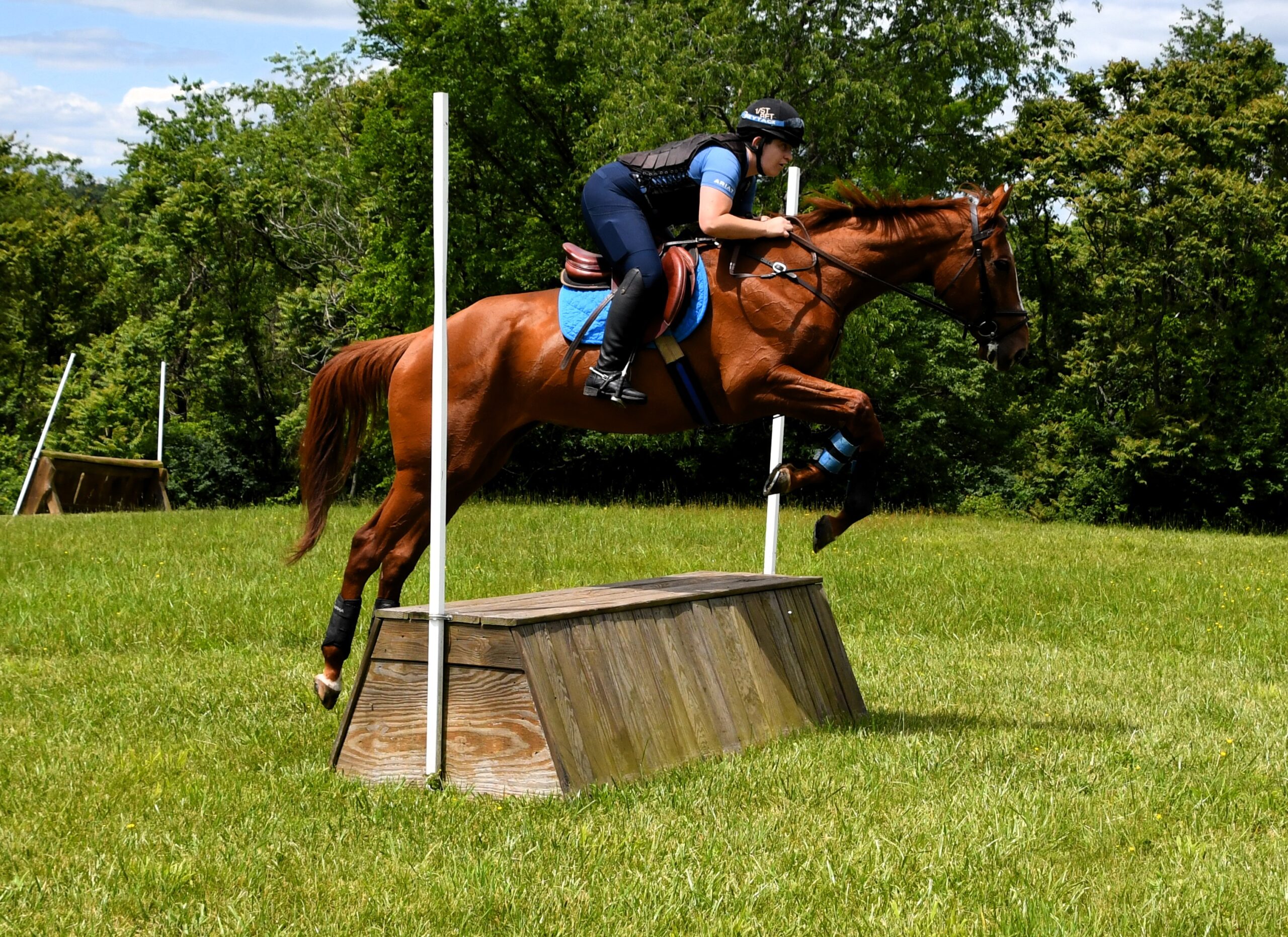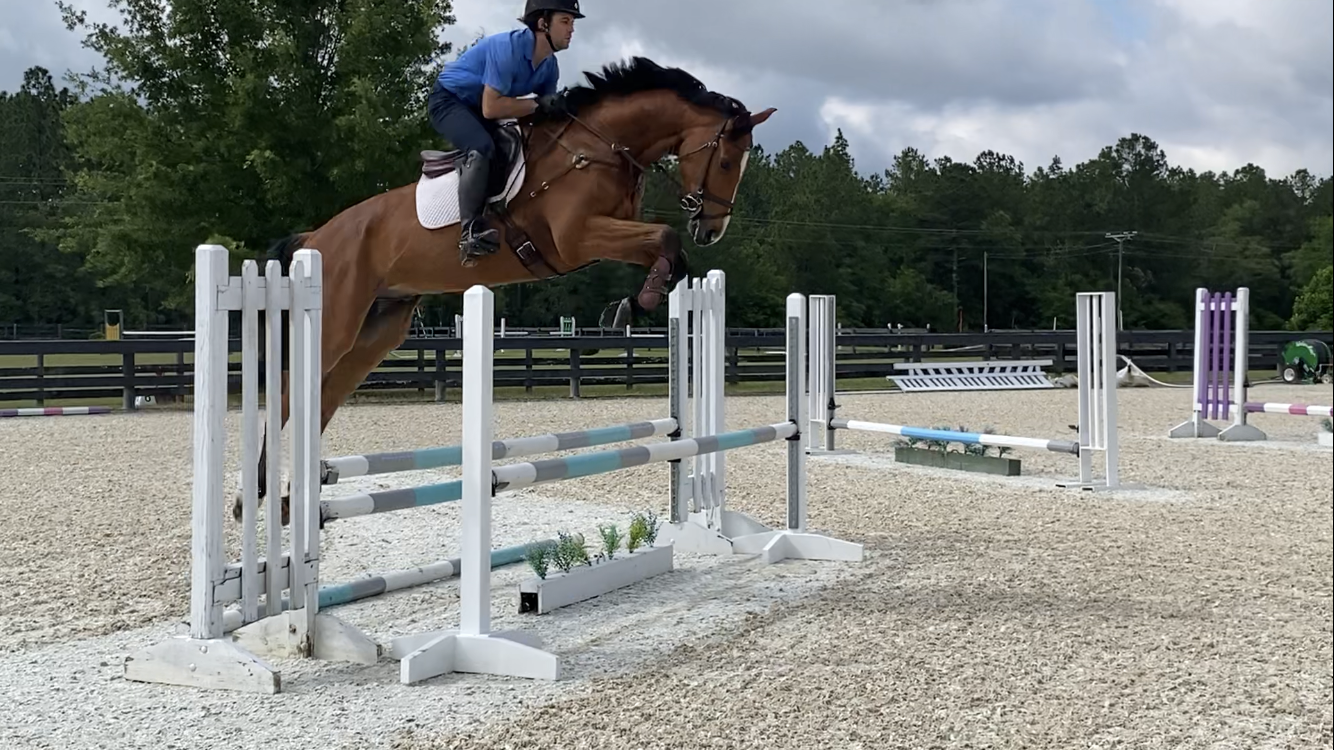
Margaret Thomas jumping Phinn in a Buck Davidson clinic last January.
Dear Leslie,
I am recently springing into the eventing world, literally springing… off the back of my horse. My fiery little mustang has a very bad problem with separation anxiety from “his” herd. Dressage is disastrous (I’m talking head straight in the air, hollering at all of his friends), cross country is worse (bucking, bolting, rearing or just gluing his feet to the ground). By the time we get to stadium he is POOPED from working himself up during the first two phases. What can one do with such a boisterous horse with unlimited potential?!
Thanks a ton,
Frustrated
—
Dear Frustrated,
Welcome to the wild, wacky world of eventing, emphasis on “wild” for you. Eventing a mustang comes with some unique challenges, but the payoff can be huge. The breed is known for being smart, sturdy and sound–that’s music to any eventer’s ears.
My own personal experience with mustangs is limited to falling asleep halfway through Spirit: Stallion of the Cimarron. So rather than giving you some terrible, made-up advice based on half an animated movie, I thought I’d put you in touch with someone who actually knows what they’re talking about.
Margaret Thomas is a Maryland-based eventer who has been the proud owner of a mustang for two years. Must Tango (“Phinn”) first caught Margaret’s eye as a 4-year-old when he jumped out of a 5-foot-tall round pen at her dressage trainer’s barn. “He was wild as a March Hare,” she recalls.
But Margaret was intrigued rather than intimidated. She started working with Phinn and discovered that beneath the lawless exterior was a smart, forward-thinking horse that just needed a mom and a job.
She also quickly realized that training a mustang was different in some ways than training other horses. “In the wild, if there’s a perceived threat they either flee or fight until it goes away,” she says. “You have to think about that in terms of everything you do with a mustang.”
Margaret learned that she couldn’t force Phinn to do anything; he was genetically pre-programmed to not back down in a confrontational situation. Instead, the most effective training strategy was to break everything down into smaller steps that her horse could understand.
When I read Margaret your email, Frustrated, her first response was to separate the various issues.
First, she said, there’s the issue of your horse being herd-bound, the natural result of having lived under circumstances in which being part of a group was critical for survival. The bad news is, it’s impossible to totally train that instinct out of your mustang. The good news is, by gradually gaining his trust though fair, positive training experiences, the role you play in his social life can evolve. “With Phinn, I am his herd,” Margaret says.
As for the bucking, bolting, rearing and balking, Margaret suggests that your horse’s behavioral problems boil down to basic training issues: He’s not on your aids. For Phinn, whose recurring behavior problem is spooking, punishing him for his natural hyper-awareness of his surroundings is unproductive. Instead, Margaret makes the most of the variables that she can control.
Margaret recalls a Jimmy Wofford cross-country clinic she was riding in during which Phinn took offense to some flowers in front of a fence. “He ended up on top of the fence,” Margaret says, “like a goat.” In Jimmy’s mind, the problem wasn’t the flowers, the jump or the behavior. The problem was Phinn’s lack of response to his rider’s aids: “He told me, the horse has to go forward when you put your leg on, no matter what.”
That’s some tough stuff to work out, and a horse show probably isn’t the place to do it. Begin with the basics, making sure that your horse will move away from pressure (leg, hand and whip) in any situation. Start in the barn aisle, then the round pen, then the dressage arena, then the jumping ring, then a cross-country course, then schooling shows, and then–finally–events. Use the herd mentality as a training tool, letting him follow other horses over jumps to gain confidence. Start with small solo outings and gradually work toward longer ones. Help him understand that he has the most awesome job in the world and that you’re his best friend ever.
“I want my horse to realize that, at the end of the day, I’m the best deal they’ve got going for them in this situation. That if I tell them it’s OK, it’s OK,” Margaret says.
Margaret admits that it’s a big responsibility but that embarking upon that journey with her own mustang has been an invaluable experience. “I knew when I got Phinn that this was going to be a journey,” she says. “It was going to be a relationship for a lifetime. It’s been a really wonderful opportunity to bring me back to the center of why I do this in the first place.”
If I was you, Frustrated, I’d enlist the help of a good trainer who can assist you in the process of selling your mustang on his new job. Read everything about equine behavior you can get your hands on to better get inside your horse’s head. There are lots of resources out there to help guide you, including Margaret’s own blogs here (older entries) and here (newer entries) chronicling her adventures with Phinn.
Good luck!
Leslie
p.s. Here are a couple of mustang eventing success stories to cheer you on.

Tomorrow’s Sun: Megan Betzel of Landrum, SC, competed “Zak” through prelim eventing and 3rd level dressage. Megan’s mother Kathleen is currently competing him at 4th level and working toward her USDF silver medal. Zak is half-mustang, half-Hanoverian and registered with the American Mustang & Burro Association. “He has the mind, personality and heart of a Mustang,” Megan says. “On cross-country, I could point him at anything–he’s fearless.” (Photo used with permission from Mark Walter Lehner of www.HoofClix.com)

Beam Me Up Scotty: Owned by Molly Hensley of Knoxville, Tenn., Scotty’s been showing riders the ropes of eventing for many years. “He’s the best horse ever,” Molly says. “He’s a once in a lifetime kind of horse. I always felt like he was going to take care of me. He’s so surefooted over terrain and clever over jumps–I’ve never felt safer on the back of a horse.” Most recently, Scotty competed at the 2011 AECs at Beginner Novice with junior rider Samantha Monnig. (Photo used with permission from WNC Photography)
—
Have a question for the “expert”? Email it to [email protected].






















